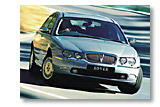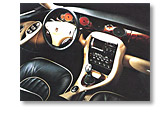

“By the time BMW arrived”, continues Woolley, “we were already working on the full scale clay model (that is essentially on the definitive car, since the final fibreglass model was based on its clay predecessor). We’d also sketched out a few ideas for the cabin. Wolfgang Reitzle said: “Fine, carry on. In fact BMW backed us up in every possible way, offering assistance, facilities and advice, but letting us work in total freedom”.
The aim throughout was to come up with a thoroughly “British” product that respected the Rover tradition and the brand values that the firm had rather lost sight of in the recent past. “One distinguishing feature of Rovers and all traditional British cars is their proportions”, explains Woolley.
“On modern cars the front and rear overhangs tend to be almost identical. By contrast, on the 75 the front overhang is shortish and the tail is longer, as elegant as a little limousine. The cabin creates a sheltered environment that gives its occupants a protected feeling and a sense of privacy thanks to the rather robust D pillar”.
The “classic” proportions of the new saloon go with a body on which the waistline rises at the front and then drops down towards the tail.
Richard Woolley believes that the ensemble creates a dynamic effect of a rather special kind. “We weren’t going for any kind of aggressive look. In fact I rather feel that some wedge shapes create precisely the opposite effect, the impression a shape that comes to a stop. Our saloon is a flowing shape that “slips” along the road”. At 4745 mm long (midway between the 600 and 800 series) the Rover 75 is built on a new floorpan. The wheelbase is 2745 mm long and the width and height are 1778 mm and 1427 mm respectively.
The article continues in Auto & Design no. 114










